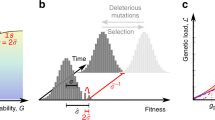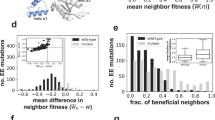Abstract
The emergence of natural selection, requiring that reproducing entities present variations that may be inherited and passed on, was arguably the most important breakthrough in the self-organization of life. In this Perspective, the assumptions governing biological reproduction are confronted with physico-chemical principles that control the evolution of material systems. In biology, the reproduction of living organisms is never considered to be reversible, whereas microscopic reversibility is an essential principle in the physical description of matter. Here, we show that this discrepancy places constraints on the possibility of finding kinetic processes in the chemical world that are equivalent to natural selection in the biological one. Chemical replicators can behave in a similar fashion to living entities, provided that the reproduction cycle proceeds in a unidirectional way. For this to be the case, kinetic barriers must hinder the reverse process. The system must, thus, be held far from equilibrium and fed with a non-degraded (low-entropy) form of energy. The ensuing constraints must be factored in when proposing scenarios that account for the origin of life at the molecular level.
This is a preview of subscription content, access via your institution
Access options
Access Nature and 54 other Nature Portfolio journals
Get Nature+, our best-value online-access subscription
$29.99 / 30 days
cancel any time
Subscribe to this journal
Receive 12 digital issues and online access to articles
$119.00 per year
only $9.92 per issue
Buy this article
- Purchase on Springer Link
- Instant access to full article PDF
Prices may be subject to local taxes which are calculated during checkout



Similar content being viewed by others
References
Darwin, C. On the Origin of Species (Harvard Univ. Press, 1859).
Watson, J. D. & Crick, F. H. C. Molecular structure of nucleic acids - a structure for deoxyribose nucleic acid. Nature 171, 737–738 (1953).
Barboiu, M. Dynamic interactive systems: dynamic selection in hybrid organic–inorganic constitutional networks. Chem. Commun. 46, 7466–7476 (2010).
Wicken, J. S. An organismic critique of molecular darwinism. J. Theor. Biol. 117, 545–561 (1985).
Sharp, P. M. In search of molecular darwinism. Nature 385, 111–112 (1997).
Huc, I. & Lehn, J.-M. Virtual combinatorial libraries: dynamic generation of molecular and supramolecular diversity by self-assembly. Proc. Natl Acad. Sci. USA 94, 2106–2110 (1997).
Herrmann-Pillath, C. Entropy, function and evolution: naturalizing peircian semiosis. Entropy 12, 197–242 (2010).
Popa, R. Necessity, futility and the possibility of defining life are all embedded in its origin as a punctuated-gradualism. Orig. Life Evol. Biosph. 40, 183–190 (2010).
Depew, D. J. & Weber, B. H. The fate of darwinism: evolution after the modern synthesis. Biol. Theory 6, 89–102 (2011).
Saladino, R. et al. Chemomimesis and molecular Darwinism in action: from abiotic generation of nucleobases to nucleosides and RNA. Life 8, 24 (2018).
Lewis, G. N. A new principle of equilibrium. Proc. Natl Acad. Sci. USA 11, 179–183 (1925).
Ragazzon, G. & Prins, L. J. Energy consumption in chemical fuel-driven self-assembly. Nat. Nanotechnol. 13, 882–889 (2018).
Van Esch, J. H., Klajn, R. & Otto, S. Chemical systems out of equilibrium. Chem. Soc. Rev. 46, 5474–5475 (2017).
Grzybowski, B. A., Fitzner, K., Paczesny, J. & Granick, S. From dynamic self-assembly to networked chemical systems. Chem. Soc. Rev. 46, 5647–5678 (2017).
van Rossum, S. A. P. A., Tena-Solsona, M., van Esch, J. H., Eelkema, R. & Boekhoven, J. Dissipative out-of-equilibrium assembly of man-made supramolecular materials. Chem. Soc. Rev. 46, 5519–5535 (2017).
Astumian, R. D. Trajectory and cycle-based thermodynamics and kinetics of molecular machines: the importance of microscopic reversibility. Acc. Chem. Res. 51, 2653–2661 (2018).
Demetrius, L. Directionality principles in thermodynamics and evolution. Proc. Natl Acad. Sci. USA 94, 3491–3498 (1997).
Pross, A. & Khodorkovsky, V. Extending the concept of kinetic stability: toward a paradigm for life. J. Phys. Org. Chem. 17, 312–316 (2004).
Pross, A. What is Life? (Oxford Univ. Press, 2016).
Pross, A. Seeking the chemical roots of Darwinism: bridging between chemistry and biology. Chem. Eur. J. 15, 8374–8381 (2009).
Pascal, R. & Pross, A. Chemistry’s kinetic dimension and the physical basis for life. J. Syst. Chem. 7, 1–8 (2019).
Pascal, R. & Pross, A. Stability and its manifestation in the chemical and biological worlds. Chem. Commun. 51, 16160–16165 (2015).
Pascal, R. Suitable energetic conditions for dynamic chemical complexity and the living state. J. Syst. Chem. 3, 3 (2012).
Pascal, R., Pross, A. & Sutherland, J. D. Towards an evolutionary theory of the origin of life based on kinetics and thermodynamics. Open Biol. 3, 130156 (2013).
Pross, A. & Pascal, R. How and why kinetics, thermodynamics, and chemistry induce the logic of biological evolution. Beilstein J. Org. Chem. 13, 665–674 (2017).
Lehn, J.-M. Dynamic combinatorial chemistry and virtual combinatorial libraries. Chem. Eur. J. 5, 2455–2463 (1999).
Cousins, G. R. L., Poulsen, S.-A. & Sanders, J. K. M. Molecular evolution: dynamic combinatorial libraries, autocatalytic networks and the quest for molecular function. Curr. Opin. Chem. Biol. 4, 270–279 (2000).
Rozenman, M. M., McNaughton, B. R. & Liu, D. R. Solving chemical problems through the application of evolutionary principles. Curr. Opin. Chem. Biol. 11, 259–268 (2007).
Ruiz-Mirazo, K., Pereto, J. & Moreno, A. A universal definition of life: autonomy and open-ended evolution. Orig. Life Evol. Biosph. 34, 323–346 (2004).
Lotka, A. J. Natural selection as a physical principle. Proc. Natl Acad. Sci. USA 8, 151–154 (1922).
Mills, D. R., Peterson, R. L. & Spiegelman, S. An extracellular Darwinian experiment with a self-duplicating nucleic acid molecule. Proc. Natl Acad. Sci. USA 58, 217–224 (1967).
Orgel, L. E. Prebiotic chemistry and the origin of the RNA world. Crit. Rev. Biochem. Mol. Biol. 39, 99–123 (2004).
Eigen, M. Selforganization of matter and the evolution of biological macromolecules. Naturwissenschaften 58, 465–523 (1971).
Eigen, M. & Schuster, P. The hypercycle. A principle of natural self-organization. Part A. The emergence of the hypercycle. Naturwissenschaften 64, 541–565 (1977).
Szathmáry, E. & Gladkih, I. Sub-exponential growth and coexistence of non-enzymatically replicating templates. J. Theor. Biol. 138, 55–58 (1989).
von Kiedrowski, G. A self-replicating hexadeoxynucleotide. Angew. Chem. Int. Ed. Engl. 25, 932–935 (1986).
Prigogine, I. Time, structure and fluctuations. Science 201, 777–785 (1978).
Zachar, I. & Szathmáry, E. A new replicator: a theoretical framework for analysing replication. BMC Biol. 8, 21–21 (2010).
Sutherland, J. Opinion: Studies on the origin of life — the end of the beginning. Nat. Rev. Chem. 1, 0012 (2017).
Peretó, J. in Handbook of Astrobiology Ch. 5.1 (ed. Kolb, V. M.) 219–233 (CRC, 2019).
Ruiz-Mirazo, K., Briones, C. & de la Escosura, A. Prebiotic systems chemistry: new perspectives for the origins of life. Chem. Rev. 114, 285–366 (2014).
Pascal, R. in Astrochemistry and Astrobiology: Physical Chemistry in Action (eds Smith, I. W. M., Cockell C. & Leach S.) 243–269 (Springer, 2013).
Jencks, W. P. in Handbook of Biochemistry and Molecular Biology 3rd edn Vol. I (ed. Fasman, G. D.) 296–304 (CRC, 1976).
Pross, A. The evolutionary origin of biological function and complexity. J. Mol. Evol. 76, 185–191 (2013).
Astumian, R. D. & Robertson, B. Imposed oscillations of kinetic barriers can cause an enzyme to drive a chemical reaction away from equilibrium. J. Am. Chem. Soc. 115, 11063–11068 (1993).
Kreysing, M., Keil, L., Lanzmich, S. & Braun, D. Heat flux across an open pore enables the continuous replication and selection of oligonucleotides towards increasing length. Nat. Chem. 7, 203–208 (2015).
Colomb-Delsuc, M., Mattia, E., Sadownik, J. W. & Otto, S. Exponential self-replication enabled through a fibre elongation/breakage mechanism. Nat. Commun. 6, 7427 (2015).
Duval, S. et al. Fougerite: the not so simple progenitor of the first cells. Interface Focus 9, 20190063 (2019).
England, J. L. Statistical physics of self-replication. J. Chem. Phys. 139, 121923 (2013).
Martyushev, L. M. & Seleznev, V. D. Maximum entropy production principle in physics, chemistry and biology. Phys. Rep. 426, 1–45 (2006).
Ross, J., Corlan, A. D. & Müller, S. C. Proposed principles of maximum local entropy production. J. Phys. Chem. B 116, 7858–7865 (2012).
Wells, T. N. C., Ho, C. K. & Fersht, A. R. Free energy of hydrolysis of tyrosyl adenylate and its binding to wild-type and engineered mutant tyrosyl-tRNA synthetases. Biochemistry 25, 6603–6608 (1986).
Cramer, F. & Freist, W. Molecular recognition by energy dissipation, a new enzymatic principle: the example isoleucine-valine. Acc. Chem. Res. 20, 79–84 (1987).
Mitchell, P. Compartmentation and communication in living systems. Ligand conduction: a general catalytic principle in chemical, osmotic and chemiosmotic reaction systems. Eur. J. Biochem. 95, 1–20 (1979).
Dibrova, D. V., Galperin, M. Y., Koonin, E. V. & Mulkidjanian, A. Y. Ancient systems of sodium/potassium homeostasis as predecessors of membrane bioenergetics. Biochemistry 80, 495–516 (2015).
Pascal, R. & Boiteau, L. Energy flows, metabolism and translation. Phil. Trans. R. Soc. Lond. B Biol. Sci. 366, 2949–2958 (2011).
Lineweaver, C. H. & Egan, C. A. Life, gravity and the second law of thermodynamics. Phys. Life Rev. 5, 225–242 (2008).
Pascal, R. Kinetic barriers and the self-organization of life. Isr. J. Chem. 55, 865–874 (2015).
Wolfenden, R. Primordial chemistry and enzyme evolution in a hot environment. Cell. Mol. Life Sci. 71, 2909–2915 (2014).
Mitchell, P. Coupling of phosphorylation to electron and hydrogen transfer by a chemi-osmotic type of mechanism. Nature 191, 144–148 (1961).
Eschenmoser, A. Chemistry of potentially prebiological natural products. Orig. Life Evol. Biosph. 24, 389–423 (1994).
Eschenmoser, A. Etiology of potentially primordial biomolecular structures: from vitamin B12 to the nucleic acids and an inquiry into the chemistry of life’s origin: a retrospective. Angew. Chem. Int. Ed. 50, 12412–12472 (2011).
Westheimer, F. H. Why nature chose phosphate. Science 235, 1173–1178 (1987).
Pascal, R., Taillades, J. & Commeyras, A. Systèmes de Strecker et apparentés—XII: Catalyse par les aldéhydes de l’hydratation intramoléculaire des α-aminonitriles. Tetrahedron 36, 2999–3008 (1980).
Canavelli, P., Islam, S. & Powner, M. Peptide ligation by chemoselective aminonitrile coupling in water. Nature 571, 546–549 (2019).
Patel, B. H., Percivalle, C., Ritson, D. J., Duffy, C. D. & Sutherland, J. D. Common origins of RNA, protein and lipid precursors in a cyanosulfidic protometabolism. Nat. Chem. 7, 301–307 (2015).
Walker, S. I. The new physics needed to probe the origins of life. Nature 569, 36–38 (2019).
Vasas, V., Szathmáry, E. & Santos, M. Lack of evolvability in self-sustaining autocatalytic networks constraints metabolism-first scenarios for the origin of life. Proc. Natl Acad. Sci. USA 107, 1470–1475 (2010).
Vasas, V., Fernando, C., Santos, M., Kauffman, S. & Szathmáry, E. Evolution before genes. Biol. Direct 7, 1 (2012).
Segré, D., Ben-Eli, D. & Lancet, D. Compositional genomes: prebiotic information transfer in mutually catalytic noncovalent assemblies. Proc. Natl Acad. Sci. USA 97, 4112–4117 (2000).
Lahav, N., White, D. & Chang, S. Peptide formation in the prebiotic era: thermal condensation of glycine in fluctuating clay environments. Science 201, 67–69 (1978).
Olasagasti, F., Kim, H. J., Pourmand, N. & Deamer, D. W. Non-enzymatic transfer of sequence information under plausible prebiotic conditions. Biochimie 93, 556–561 (2011).
Campbell, T. D. et al. Prebiotic condensation through wet–dry cycling regulated by deliquescence. Nat. Commun. 10, 4508 (2019).
Acknowledgements
R.P. thanks A. Pross for long-lasting exchanges of invaluable help in the development of concepts related to dynamic kinetic stability and for helpful suggestions on a previous version of the text.
Author information
Authors and Affiliations
Contributions
R.P. conceived the project. All authors contributed to its development and wrote the manuscript.
Corresponding author
Ethics declarations
Competing interests
The authors declare no competing interests.
Additional information
Publisher’s note
Springer Nature remains neutral with regard to jurisdictional claims in published maps and institutional affiliations.
Rights and permissions
About this article
Cite this article
Danger, G., d’Hendecourt, L.L.S. & Pascal, R. On the conditions for mimicking natural selection in chemical systems. Nat Rev Chem 4, 102–109 (2020). https://doi.org/10.1038/s41570-019-0155-6
Accepted:
Published:
Issue Date:
DOI: https://doi.org/10.1038/s41570-019-0155-6
This article is cited by
-
Stoechiometric and dynamical autocatalysis for diluted chemical reaction networks
Journal of Mathematical Biology (2022)
-
A physicochemical orthophosphate cycle via a kinetically stable thermodynamically activated intermediate enables mild prebiotic phosphorylations
Nature Communications (2021)



